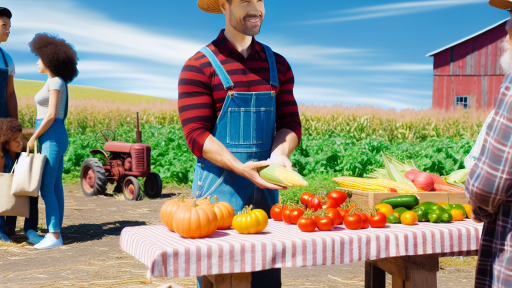Introduction to Seasonal Eating
Understanding Its Importance for Farm-to-Table Farmers
Seasonal eating is vital for farm-to-table farmers.
It promotes the use of fresh, locally-sourced ingredients.
Moreover, seasonal eating enhances flavor and quality in food.
Farmers benefit from understanding the rhythms of nature.
This knowledge allows them to grow crops that thrive at specific times.
Environmental Benefits
Seasonal eating supports sustainable agricultural practices.
It reduces the carbon footprint associated with transportation.
Additionally, it encourages biodiversity on farms.
Farmers that focus on seasonal crops help maintain soil health.
Healthy soil produces better quality food over time.
Economic Advantages
By embracing seasonal eating, farmers can boost their profits.
They can sell more produce directly to consumers.
Consumer demand for fresh, local food often increases profits.
Furthermore, seasonal produce can command higher prices.
Ultimately, this strategy supports local economies.
Transform Your Agribusiness
Unlock your farm's potential with expert advice tailored to your needs. Get actionable steps that drive real results.
Get StartedBuilding Community Connections
Seasonal eating fosters community among farmers and consumers.
It encourages relationships with local restaurants and markets.
By collaborating, farmers can share their harvests effectively.
Such connections cultivate a supportive network.
Moreover, consumers become more educated about food sources.
Emphasizing Health Benefits
Eating with the seasons has notable health benefits.
Seasonal fruits and vegetables are rich in nutrients.
They are also more flavorful than out-of-season produce.
Additionally, a varied diet supports overall health.
Unique seasonal ingredients inspire culinary creativity.
Overcoming Challenges
Farmers may face hurdles with seasonal eating.
Weather variability can impact crop yields significantly.
However, planning and education can mitigate risks.
Farmers can diversify crops to handle unexpected changes.
Taking part in community-supported agriculture can also help.
Benefits of Seasonal Eating
Nutritional Advantages
Seasonal eating offers numerous nutritional benefits.
Fruits and vegetables picked at peak ripeness provide optimal nutrients.
Furthermore, they often contain higher levels of antioxidants and vitamins.
Seasonally consumed produce supports a balanced diet and enhances overall health.
Additionally, local farms often grow varieties with unique flavors and nutrients.
Environmental Benefits
Seasonal eating reduces carbon footprints significantly.
When you buy local produce, you minimize transportation emissions.
This practice also supports biodiversity within the local ecosystem.
Seasonal farming often employs sustainable practices that protect soil health.
Showcase Your Farming Business
Publish your professional farming services profile on our blog for a one-time fee of $200 and reach a dedicated audience of farmers and agribusiness owners.
Publish Your ProfileMoreover, it reduces reliance on harmful pesticides and chemical fertilizers.
Economic Advantages
Purchasing seasonal produce boosts the local economy.
It directly supports local farmers and their communities.
This enhances the resilience of local food systems.
Additionally, seasonal foods tend to be more affordable due to lower costs.
Buying in-season products encourages a fresh assortment to consumers.
Identifying Seasonal Produce: A Guide for Farmers and Consumers
Understanding Seasonal Cycles
Seasonal eating revolves around understanding the natural cycles of produce growth.
Farmers can benefit from knowing the ideal planting and harvest times.
Consumers enjoy fresher flavors by eating what’s in season.
Key Seasonal Groups
Fruits and vegetables vary widely with the seasons.
Understanding these categories aids both farmers and consumers.
- Spring offers fresh greens like spinach and asparagus.
- Summer brings vibrant tomatoes and peppers.
- Autumn features hearty root vegetables such as carrots and squash.
- Winter often serves citrus fruits and storage crops.
Resources to Identify Seasonal Produce
Multiple resources help in identifying seasonal produce.
Farmers’ markets frequently highlight seasonal items.
Additionally, local agricultural websites can provide useful lists.
Mobile apps also track seasonal availability effectively.
Adapting Agricultural Practices
Farmers should adapt their practices to seasonality.
Crop rotation maximizes soil health and crop yield.
Implementing intercropping techniques can optimize space and resources.
Moreover, diversifying crops reduces risks associated with climate change.
Engaging Consumers
Education plays a vital role in connecting consumers to seasonal produce.
Farmers can offer farm tours and workshops to share knowledge.
Promoting seasonal recipes through social media can inspire menu changes.
This engagement creates a sustainable cycle of seasonal eating.
Gain More Insights: Essential Small-Scale Farming Techniques for Beginners
Strategies for Implementing Seasonal Eating Practices on Farms
Understanding Seasonal Foods
Seasonal foods strongly reflect local climate and soil conditions.
Farmers should learn which crops thrive during specific seasons.
By understanding this, farmers can plan their planting schedules effectively.
Additionally, they can educate consumers about the benefits of seasonal eating.
Engaging with the Community
Building relationships with local chefs can enhance farm visibility.
Chefs often seek fresh seasonal ingredients for their menus.
Farmers can organize farm-to-table events, fostering community engagement.
These events showcase the seasonal produce and raise awareness.
Utilizing Crop Rotation
Crop rotation maximizes soil health and biodiversity.
Planting different crops each season sustains soil nutrients.
This practice promotes a sustainable farming model over time.
Furthermore, it aligns perfectly with seasonal eating principles.
Implementing Direct Marketing Strategies
Farmers can sell directly to consumers through farmers’ markets.
Seasonal produce can be highlighted in marketing materials.
Online platforms can also facilitate seasonal produce promotions.
Social media is an effective tool for sharing seasonal recipes.
Showcase Your Farming Business
Publish your professional farming services profile on our blog for a one-time fee of $200 and reach a dedicated audience of farmers and agribusiness owners.
Publish Your ProfileAdopting Sustainable Practices
Sustainable farming practices support seasonal eating initiatives.
Companion planting can enhance crop yields and pest management.
Farmers should consider organic methods to promote health benefits.
Lastly, minimizing food waste contributes to sustainability efforts.
Educating Consumers
Workshops can help inform consumers about seasonal eating.
Farm-to-table initiatives educate consumers on local food sourcing.
Providing recipe cards for seasonal ingredients is an effective strategy.
More education leads to increased appreciation for local produce.
Gain More Insights: Integrating Agri-Tourism into Your Farm Business
Marketing Seasonal Produce
Building Community Awareness
Start by educating your community about seasonal produce.
Offer workshops and cooking demonstrations to showcase fresh ingredients.
Engage local schools with programs that highlight healthy eating.
Host farm tours to create an appreciation for local farming practices.
Leveraging Social Media
Utilize social media platforms to promote your seasonal offerings.
Share beautiful photos of fresh produce to attract attention.
Encourage customers to tag you in their posts about your products.
Utilize hashtags related to farm-to-table to reach a larger audience.
Collaborating with Local Businesses
Partner with local restaurants to feature your produce on their menus.
Create joint marketing campaigns with nearby farmers’ markets.
Offer businesses special discounts for bulk purchases of seasonal produce.
Organize events with local chefs who specialize in using seasonal ingredients.
Creating Seasonal Subscription Boxes
Design subscription boxes that deliver seasonal produce directly to customers.
Include easy-to-follow recipes for using the featured produce.
Offer customizable options to cater to different dietary preferences.
Promote the subscription service via your website and social media channels.
Encouraging Customer Engagement
Develop a loyalty program that rewards repeat customers.
Host seasonal contests to encourage participation and sharing.
Ask for feedback on which seasonal items customers prefer.
Utilize this feedback to tailor your offerings based on demand.
Gain More Insights: Ethical Farming For Small Farms
Collaboration with Local Chefs and Restaurants
Establishing Connections
Farmers can greatly benefit from building relationships with local chefs.
These partnerships foster a mutual appreciation for fresh ingredients.
They allow chefs to use seasonal produce in their menus.
Furthermore, farmers gain insight into culinary trends and preferences.
This collaboration encourages the exchange of ideas and innovations.
Creating Seasonal Menus
Chefs can work with farmers to develop seasonal menus.
These menus highlight the freshest available ingredients.
They promote sustainability by reducing carbon footprints.
Seasonal menus can also excite diners with variety.
Moreover, they enhance the dining experience through freshness.
Showcase Your Farming Business
Publish your professional farming services profile on our blog for a one-time fee of $200 and reach a dedicated audience of farmers and agribusiness owners.
Publish Your ProfileHosting Farm-to-Table Events
Farmers and chefs can organize farm-to-table events together.
These events educate attendees about sourcing local ingredients.
They also showcase the quality of farm-fresh produce.
Events further strengthen community ties around local food systems.
Additionally, they provide networking opportunities for all involved.
Promoting Each Other’s Businesses
Farmers and chefs can promote one another’s businesses effectively.
Social media serves as a powerful tool for this promotion.
Collaborative posts can attract diverse audiences.
Cross-marketing enhances visibility for both parties.
This approach can lead to increased customer loyalty.
Explore Further: Creating Memorable Experiences in Agri-Tourism

Seasonal Recipes and Cooking Tips
Embracing Seasonal Ingredients
Using seasonal ingredients enhances flavor and nutrition.
Farm-to-table practices ensure freshness and quality.
Explore local farmers’ markets for the best seasonal produce.
Discover new varieties that you may not find in grocery stores.
Creative Seasonal Recipes
Seasonal recipes can inspire creativity in the kitchen.
Consider a summer salad with heirloom tomatoes and basil.
Try roasting root vegetables in the fall for a hearty dish.
In winter, a warm soup made with seasonal squash can be comforting.
Spring offers opportunities for vibrant stir-fries with fresh greens.
Cooking Techniques for Seasonal Produce
Different seasons offer unique cooking techniques to explore.
Grilling brings out the flavor of summer vegetables.
Steaming retains nutrients in delicate spring produce.
Slow cooking is ideal for tougher winter vegetables.
Experimenting with pickling can preserve summer flavors for winter use.
Engaging Consumers through Culinary Education
Culinary education helps consumers appreciate seasonal eating.
Workshops can teach skills like preserving or fermenting.
Tasting events can showcase seasonal items and recipes.
Farmers can collaborate with chefs to create special menus.
Building Community Around Seasonal Eating
Encouraging community engagement fosters a love for local food.
Organizing potlucks can celebrate seasonal ingredients.
Establish a community-supported agriculture program for direct connections.
Social media platforms can be utilized to share seasonal recipes.
The Role of Farmers’ Markets in Promoting Seasonal Eating Practices
Introduction to Farmers’ Markets
Farmers’ markets serve as vital hubs for local food systems.
They connect farmers directly with consumers.
This relationship encourages seasonal eating practices.
People are more likely to purchase what is in season.
Benefits of Seasonal Eating
Seasonal eating enhances flavor and freshness.
Fresh produce provides more nutrients and taste.
It also supports local farmers and the economy.
Showcase Your Farming Business
Publish your professional farming services profile on our blog for a one-time fee of $200 and reach a dedicated audience of farmers and agribusiness owners.
Publish Your ProfileEating seasonally reduces the carbon footprint.
Moreover, it fosters a deeper connection to food sources.
Farmers’ Markets as Educational Platforms
Farmers’ markets often host educational workshops.
These sessions share knowledge about seasonal produce.
Market visitors learn cooking tips and preservation methods.
Engaging with local farmers fosters understanding of food cycles.
Building Community Connections
Farmers’ markets strengthen community ties.
Consumers form relationships with local farmers.
Such connections help people appreciate local food sources.
They also promote a sense of place and belonging.
Promoting Seasonal Products
Farmers’ markets display seasonal produce prominently.
Signage and displays highlight what’s currently available.
Vendors encourage shoppers to choose in-season items.
This practice drives awareness of seasonal eating.
Supporting Local Agriculture
Farmers’ markets significantly benefit local agriculture.
They provide a direct sales avenue for small farms.
This support helps farmers sustain their livelihoods.
Consequently, it encourages more sustainable farming practices.
The Future of Seasonal Eating
Farmers’ markets continue to evolve in their role.
They promote not just local produce but a lifestyle.
Seasonal eating practices are essential for community health.
As awareness grows, so does the significance of farmers’ markets.
Challenges and Solutions in Seasonal Farming
Weather Variability
Weather can dramatically impact farming outcomes.
Farmers face unpredictable conditions like droughts or floods.
This unpredictability creates challenges in planning planting schedules.
Developing resilient farming practices can mitigate these risks.
Utilizing weather forecasting tools is essential for crop management.
Farmers should also consider diversified planting to reduce risk.
Crop Rotation Practices
Crop rotation enhances soil health and biodiversity.
Regularly rotating crops helps prevent soil depletion.
However, managing various crop schedules can be challenging.
Farmers must maintain records to track crop performance.
This practice aids in selecting future crops based on previous yields.
Additionally, engaging in community knowledge-sharing can foster better practices.
Consumer Trends
Understanding consumer preferences is vital for farmers.
Seasonal eating is gaining popularity among many consumers.
This trend encourages consumers to purchase locally sourced food.
Regularly updating market research helps farmers adapt to these trends.
Farmers can also build relationships with local restaurants and markets.
Offering subscription services for seasonal produce can enhance sales.
Showcase Your Farming Business
Publish your professional farming services profile on our blog for a one-time fee of $200 and reach a dedicated audience of farmers and agribusiness owners.
Publish Your ProfileEffective Marketing Strategies
Using social media to promote seasonal offerings is effective.
Farmers should highlight the benefits of seasonal produce.
This strategy engages customers and showcases farm activities.
Participating in farmers markets builds community relationships.
Moreover, educational workshops can attract consumers to seasonal eating.
Additional Resources
Farm-to-Table Movement: Building a Direct Connection to Your Food
Farm to Table: Building Local and Regional Food Systems – SARE




